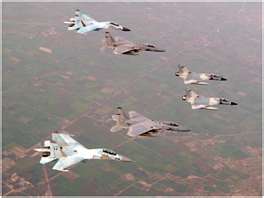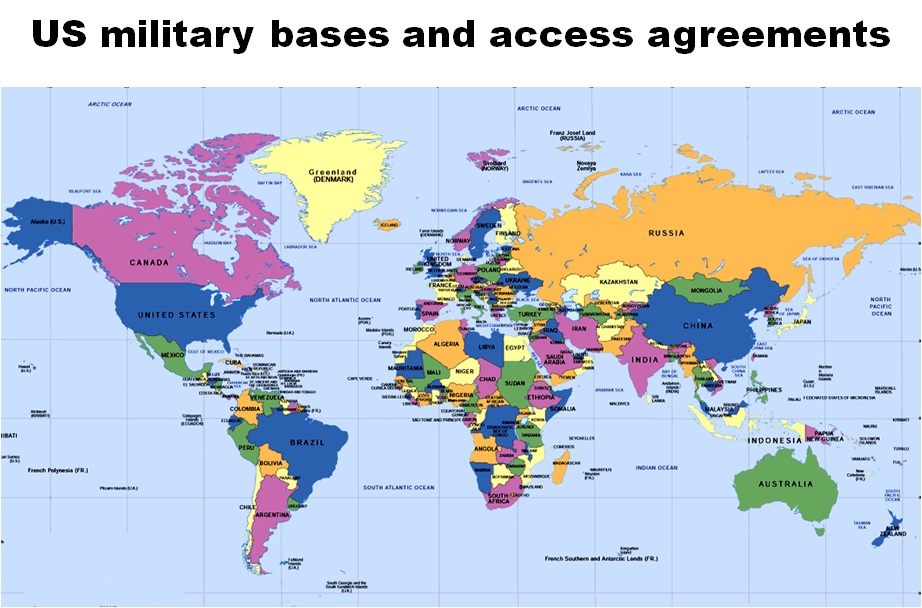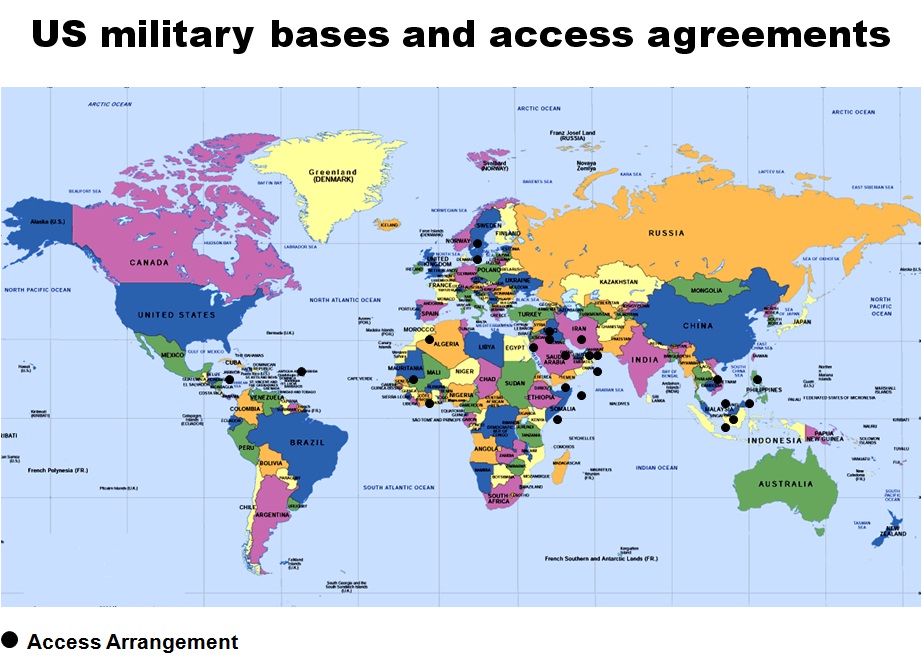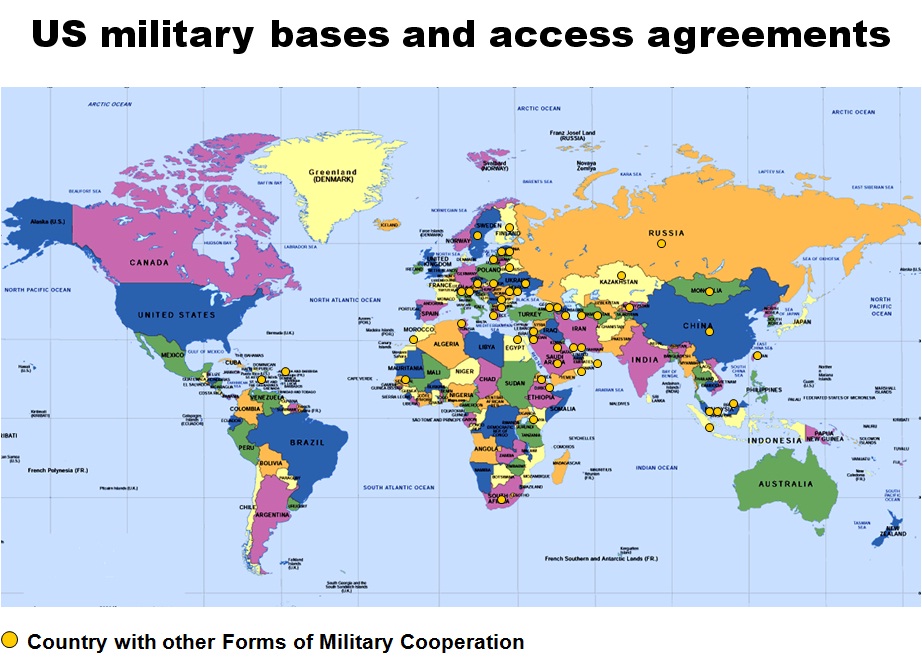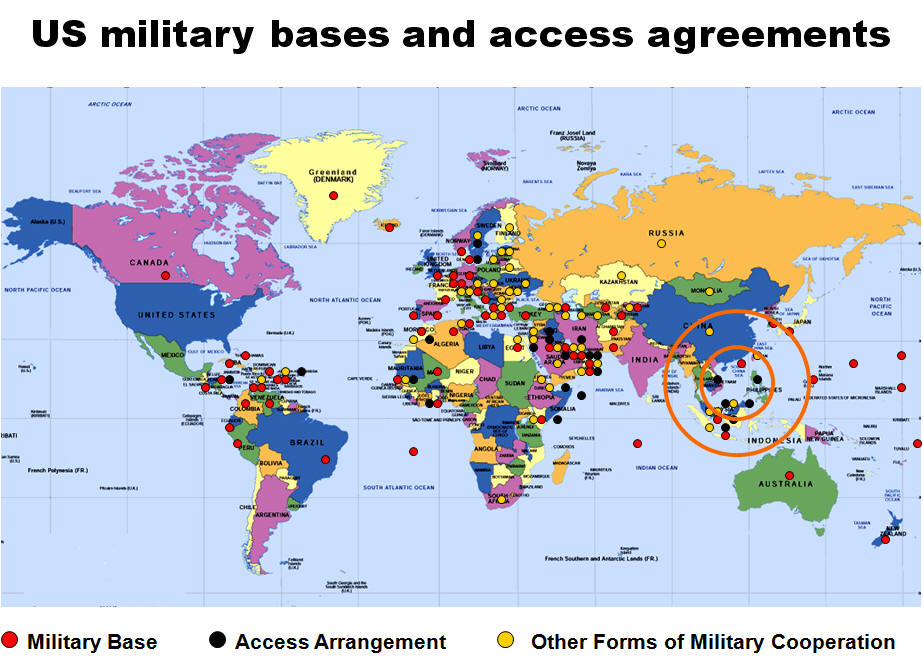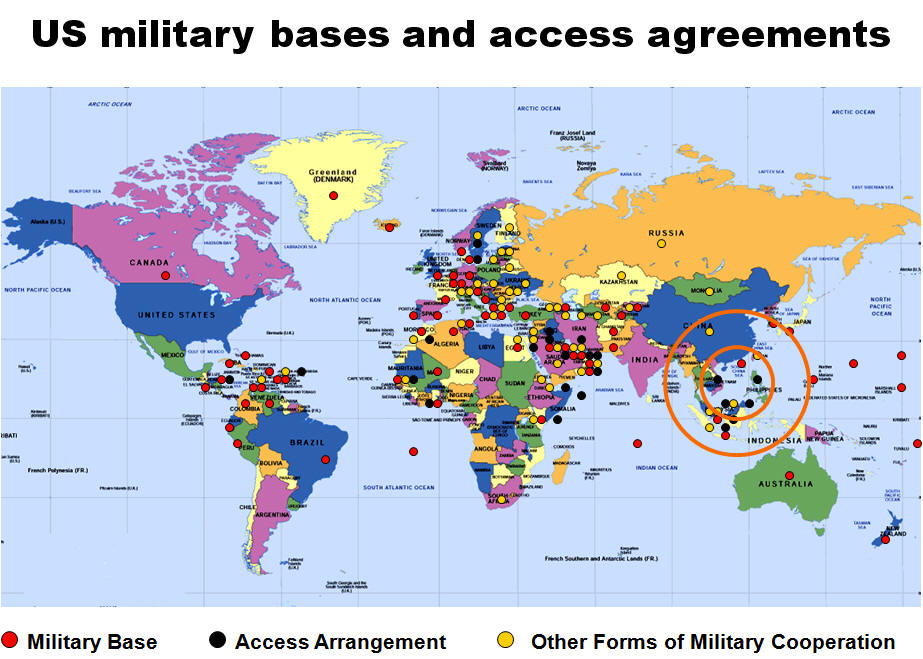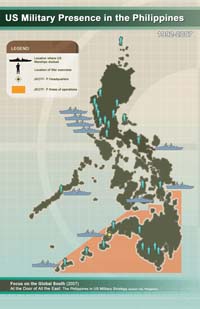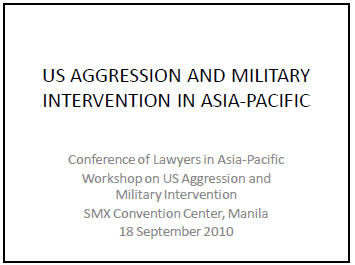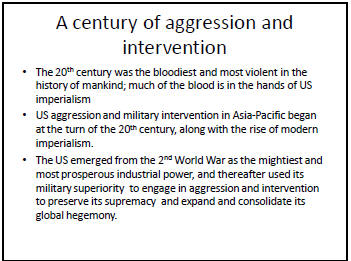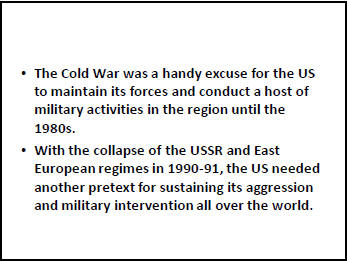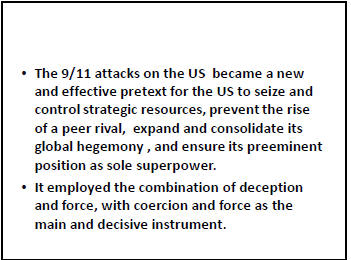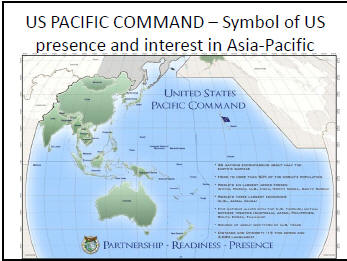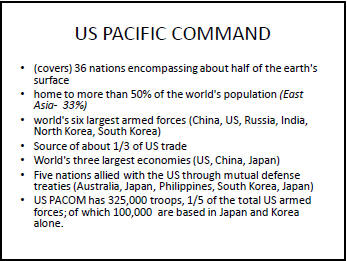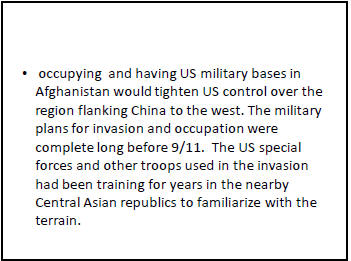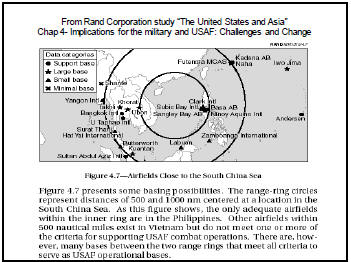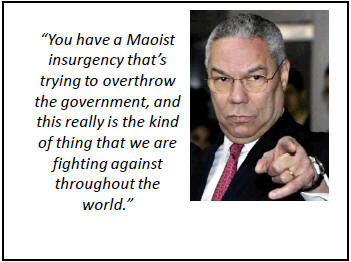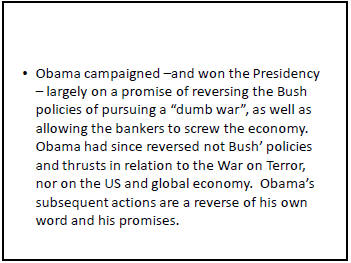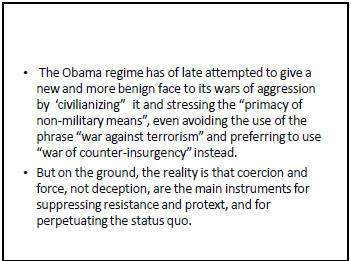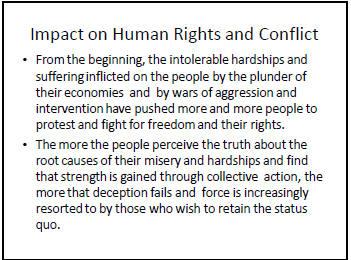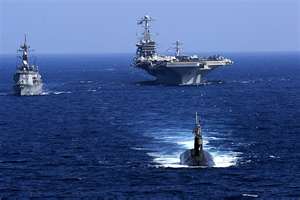Rey Claro Casambre
Philppine Peace Center
13 November 2002
A couple of days ago, the United Nations Security Council voted unanimously in favor of a US-
sponsored resolution with regard to Iraq. The resolution compels Saddam Hussein of Iraq to allow a team of UN inspectors to ascertain the veracity of the Iraqi leader’s pronouncements on Iraq’s manufacture and possession of nuclear, biological and chemical weapons or “weapons of mass destruction”. Opinions are divided on whether or not in the long run, this resolution will lead us closer to world peace, depending on whether or not you are, as Bush says, “with us or against us”. But there is little disagreement that in the short run, it means that it will only be a matter of time when the US would once again unleash a full-scale offensive against Iraq, with the objective of deposing Saddam, gaining control of the immense Iraqi oil reserves and consolidating US hold on Western Asia.
US President George Bush struggles and strains to pass this off as part of the US-led “war against terrorism” and a logical sequel to the war on Afghanistan. But opposition to the war on Iraq has been as broad as support for the Afghanistan war had been. In fact, opposition to the entire US-led “war against terror” has grown throughout the world over the past year and two months since the bombings of the World Trade Center and the Pentagon.
Questions have been raised, and attempts to give answers only give rise to more questions. Who are the terrorists? Who are behind them? Why do they hate America so much? How can they be discovered and defeated? How should they be dealt with? How will this “war on terror” be carried out? How can it succeed? Will it lead to world peace?
Here at home, few eyebrows were raised when President Macapagal-Arroyo quickly threw the Philippines’ support behind the “war on terror”, generously offering the US use of Philippine territory and resources, including Philippine troops, for the Afghanistan offensive. When US troops were deployed in Southwestern Mindanao to participate in military offensives against the Abu Sayyaf under the pretext of joint military exercises. The exercises are long over, US troops are still around. So are the Abu Sayyaf. What has been gained by compromising our sovereignty and territorial integrity? Are the US troops staying over to keep the peace, or will they cause the further escalation of armed conflict?
To answer all these questions, we must take a closer, more critical look at this US-led “war against terrorism”.
- The current US-led “war on terror” did not begin on or shortly after September 11, 2001. The war plans, including the offensive against Afghanistan to dislodge the Taliban government, were on Pres. Bush’s table a day before the terrorists crashed their planes on the WTC and the Pentagon. Thus this so-called “War on Terror” is not as it is being touted, a retaliatory strike and a defensive campaign to prevent other terrorist attacks from occurring.
- The global military offensive is closely linked, and compliments, the US-led trade and cultural offensive commonly known as “globalization”. This includes primarily the imposition on weaker states and economies of the “neo-liberal” policies of liberalization, deregulation and privatization. The breaking down of trade and protectionist barriers purportedly to allow the free flow of capital, technology, ergo, peace and prosperity – from the highly industrialized countries to the developing third world countries. The economic offensive is accompanied by the drumbeating over the demise of socialism, the victory of democracy over communism, capitalism as the end of history.The past twelve years have shown that “globalization” has resulted not in the flow of capital and high technology from the advanced economies to the backward, but rather that of greater profits from the backward to the advanced. Greater reconcentration of wealth. Bigger monopolies and supermonopolies. Global financial crises as a result of the abuse of finance capital, as exemplified by the bloated value of transactions and the flagrant misrepresentation of profits by giant conglomerates. Third world economies are drowning in an ever deeper and wider ocean of debt. Even the advanced economies – US, Europe and Japan – are bogged down in depressed growth rates and feeble recoveries.
- The Sept 11 bombings provided the impetus for the implementation of a “paradigm shift” in US global military force structure and approach. From a force structure that was greatly reduced in the wake of the end of the Cold War, to one of increased forward stationing and forward deployment. The declared objective is to be able to fight two simultaneous major wars and win them quickly and decisively with the minimum of reinforcements or redeployment of forces from one theater to another. From an approach that was multilateral – requiring military actions to be undertaken by US-led coalitions (such as the Desert Storm in 1991) and alliances (Kosovo, 1995) – to one that is unilateral (“if other governments won’t act, America will).This paradigm shift will be carried out by increasing the number of US military bases (which had been reduced with the end of the Cold War), by maintaining status-of-forces and access or logistics support agreements, and by conducting a wide variety of “stability operations”. According to the Defense Department’s Base Structure Report the US currently has military bases in at least 38 countries worldwide. This number could rise to 60 if we include newly acquired bases and forward bases such as in Saudi Arabia and the Balkans, and considerable troop concentrations in Central Asia (60,000) since 9-11. In addition, the US has access agreements with 57 countries. There are 250,000 US troops outside US territory, 200,000 on land and 50,000 at sea. One hundred thousand of these are in the Asia-Pacific region, 75,000 of which are in Northeast Asia.
Stability operations are operations conducted by US Armed Forces outside the US and US territories. They include joint military training exercises, humanitarian and civic assistance, peace-keeping, peace-enforcement, support to insurgencies, information-gathering, counternarcotics, counter-terrorist, “foreign internal defense” operations, noncombatant evacuation, arms control, “small contingency actions”, and “show of force”. These operations are planned and synchronized in such a way as to ensure or maintain a suitable and effective forward deployment of forces at all times.
Special operations forces — which include Army Rangers, Green Berets, Navy Seals, Air Force Special Forces, and the clandestine “Delta Force” – are at the core and play a key role in all these operations.A special word on the special forces: numerous independent and government (e.g., congressional) studies have raised the concern for rampant human rights violations brought about by US-sponsored training programs and by the increased deployment and use of Special Operations Forces. Since the end of the Cold War, the US has stepped up the training of surrogate forces. The US trains and employs local forces in much the same way and for much the same reason as the AFP trains and employs the CAFGUs: to economize, to bring down the casualty rate of the regulars, and to exploit the familiarity of the local forces with the terrain and the population.
Special operations forces gained fame in the Vietnam War, notably the Green Berets who were touted as highly trained, highly skilled, armed with sophisticated weapons and high-tech gizmos. Indeed, they are trained and armed to perform special missions. With the end of the Cold War, the political imperative to bring down casualty rates and military spending has further bolstered their role in the US war machine. More and more, they have been given covert roles.
Listed last but not least among the “Special Collateral Missions” of the SOFs is the following: Special activities – subject to limitations imposed by Executive Order and in conjunction with a presidential finding and congressional oversight, plan and conduct actions abroad in support of national foreign policy objectives so that the role of the U.S. government is not apparent or acknowledged publicly
As described in the US Defense Department’s Quadrennial Defense Review Report 2001, issued September 20, 2001, the “paradigm shift” visibly calls for beefing up US “forward deterrent forces” in the entire Asian region. US strategists anticipate – or predict — that these two wars would likely be fought in Asia: one in West Asia (aka Middle East) and another in Northeast Asia (Korea-Japan). Thus the increased importance of Asia to its military strategy. Thus also, the increased strategic importance of Southeast Asia, which lies midway between West Asia and Northeast Asia. And finally of the Philippines, which lies smack in the middle of Southeast Asia.
The US has currently no permanent military base between North Asia (where it has big military bases in South Korea and Japan) and Diego Garcia in the India Ocean. Rand Corporation, a US military think tank whose board of directors includes Paul Wolfowitz and whose recommendations have always been followed by Pentagon, has pointed out the need for the US to re-establish a major military base in the Philippines. The team that conducted this particular study was headed by Zalmay Khalilzad, who became a member of the US National Security Council and is the US special ambassador to Afghanistan.
- Bush has declared that the US reserves the right to act unilaterally, to make a preemptive strike, even a nuclear strike, and includes in its objectives the option for regime change, i.e., a forcible overthrow of an existing government that the US has decided to be a threat to world peace – read: US interests. All these disregard the norms of international law and infringe on the sovereignty and territorial integrity of nations. It has ignored and violated the UN Charter and UN Resolutions when it wishes and uses them when it suits its purpose. In launching the war against Afghanistan, the US did not bother to seek the approval of the UN Security Council, even if it had a good chance of gaining it.(The UN Charter allows a state to use force or attack another state in self defense when under attack by that state, or when all diplomatic means have been exhausted, or as part of a multilateral peace-enforcement action decided on by the Security Council.)
- The US has opposed ratification of the Rome Statute establishing the International Criminal Court (ICC), a permanent independent judicial body mandated to receive complaints and prosecute the gravest crimes under international law: genocide, other crimes against humanity, war crimes and the crime of aggression.The US admits that it opposes the establishment of the ICC because it does not want the operations and actions of its overseas troops to be harassed with suits filed against them with the ICC, or by the threat of being sued with the ICC for whatever acts they commit in the performance of their duties or the execution of their mission.
- The US has taken a lead in enacting “anti-terrorist” laws that suspend the constitutional rights of its citizens. The “Patriot Act” has resulted in thousands of cases of secret arrests and prolonged detention of Americans and aliens, mostly Arab and of color, violations of privacy and other violations of human rights. The US has encouraged and pressed other countries to enact and enforce similar laws under the mantle of “anti-terrorism” and “counterterrorism”.
- The US has used 9/11 to declare a polarized world: of terrorist vs counter-terrorist, with us or against us, virtually declaring war against all who would not do its bidding.The US defines terrorism as “the calculated use of unlawful violence or threat of unlawful violence …usually directed against civilians… to inculcate fear…intending to coerce or intimidate governments or societies… in pursuit of political, religious, or ideological goals.”
Is there a universal definition for “terrorism”? The United Nations has at least twelve conventions or treaties covering “terrorist” acts such as hijackings, bombings, kidnapping of civilians and civilian establishments, but does not have a single consolidated definition of what “terrorism” is. Last January, diplomats and legal advisers from more than 100 countries attempted to craft a definition that has evaded the United Nations for 30 years. This would have been the key to a comprehensive treaty against terrorism that would compel all 189 UN member-states to go after terrorists.
While there was little debate on the condemnation of any targeting of civilians, there was significant insistence on differentiating terrorists from “national liberation movements” and “resistance to foreign occupation.”
The European Union Council on Justice and Home Affairs proposed to define terrorism as, “offenses intentionally committed by an individual or a group against one or more countries, their institutions or people, with the aim of intimidating them and seriously altering or destroying the political, economic, or social structures of a country.” This proposal promptly provoked an appeal from 200 European lawyers expressing their concern that the definition could be used to crack down on legitimate dissent such as trade union strikes and anti-globalization mass protest actions.
So how can a global “war on terror” be carried out without a global definition of terrorism? This lack of a universal definition has not hampered the US from carrying out its so-called “war on terror” unilaterally. Bush’ “if you’re not with us, you’re against us” statement makes it clear whose definition matters. Ironically, the statement carries a thinly veiled threat backed up by the actual use of awesome power against those the US has considered “terrorist”.
- Not a few have pointed out that by its own definition, the US itself would turn out to be not just a terrorist but the number one terrorist or a superterrorist. It would also include several countries solidly behind the US in the global “war on terror” such as Pakistan and Israel, who are themselves guilty of violating human rights and international humanitarian law.
The conclusion is stark-clear. The US-led “war on terror” is nothing but a naked use of power to consolidate and gain more economic, political and military power under the guise of “combatting terrorism”, “defending the US”, “promoting world stability and peace”. It threatens to lead to more wars, collateral damage, violations of human rights, sovereignty of nations.
The US-led “war on terror” will not lead to world peace. As designed, its objective is to strengthen and impose US supremacy throughout the world, of shaping or creating a world that will promote the economic interests not of the world at large, not of the American nation, but only of the small clique of the wealthiest and most powerful monopolists in the US. It aims to deter and decisively and swiftly defeat all those that threaten these interests. It imposes its will by the combination of sheer coercion, bribery and deception. It puts itself above international law, and wantonly violates human rights and international humanitarian law. But this design has the grievous flaw of creating more and more enemies as it attempts –and momentarily succeeds—to do so.
Implications on the Philippines:
We can now examine and understand recent events in the Philippines in the light of the discussion above on the US-led “war on terror”.
- Philippines and Southeast Asia as “second front” in the “war against terror”.
- Strategic position
- Increased military presence: VFA, Balikatan, then Balikatan 02-1 purportedly vs Abu Sayyaf, MLSA—-> setting up a base
- Peace Negotiations
The peace negotiations between the government and the NDFP and between the government and the MILF are among the first casualties in the US-led “war on terror” in the Philippines.
Even before Sept 11, there was a quiet tug of war between the doves and hawks in government on how to go about the peace negotiations. The doves favored the continuation and even the acceleration of the formal talks wherein the substantive agenda of basic reforms to address the age-old social, political, economic and cultural problems which bring about armed conflict. The hawks favored the abandonment of the peace negotiations and recourse to greater military force to pressure the rebels to surrender or to negotiate within the framework of the Philippine Constitution.
The “war on terror” shifted the balance heavily in favor of the hawks. On March 16, Malacanang announced the unilateral suspension of formal talks with both the NDF and MILF. Backchannel talks would supposedly be undertaken instead.
On August 5, Gloria Macapagal-Arroyo ordered more troops redeployed to NPA areas, including those that have been employed in the combat operations against the Abu-Sayyaf during Balikatan 02-1. On August 9, Secretary of State Collin Powell announced the US action declaring the CPP-NPA as “foreign terrorist organizations”. This action was promptly “welcomed” by the Arroyo government, signaling a further shift away from the peace talks, given the government’s policy not to negotiate with terrorists.
August 12, the US Department of Finance included Prof. Jose Ma Sison in its list of terrorists against whom financial actions are to be taken. Prof Sison is the NDFP chief political consultant and a key person in the peace negotiations. On August 13, the Dutch government, upon the request of the US, declared the CPP-NPA and Prof. Sison as terrorists, and subsequently froze Prof. Sison’s bank account (which contained his subsidy), and withdrew his housing and other personal privileges from the Dutch government due him as a recognized political refugee who was barred from earning a living in The Netherlands.
On October 28, as a result of a country-hopping campaign by a Philippine delegation led by Secretary Ople and including Secretaries Norberto Gonzales, Silvestre Afable and Ermita, the European Council of Ministers included the NPA in their list of terrorists.
These actions, by their own pronouncements, are intended by the US, Dutch and Philippine governments to stigmatize and isolate the CPP, NPA and Prof. Sison and pressure them into “laying down their arms” and “rejoining the mainstream of society”. The NDF has condemned these moves as attempts to force them into capitulation.
All these seriously jeopardize and may have in fact already killed the peace negotiations. As pointed out, it is untenable now for the GRP and NDFP negotiations to continue with the government considering the CPP-NPA and Prof. Sison as terrorists. The NDFP has also stated that these actions by the government constitute grievous violations of prior agreements, notably the 1992 The Hague Joint Declaration and the Joint Agreement on Safety and Immunity Guarantees (JASIG).
Hopes for Peace
While the US-led “war on terror” appears to be an awesome and unstoppable war machine, it is hampered by its own contradictions, not the least of which is that it is guilty of the very terror it professes to combat.
In the US and Europe, hundreds of thousands have joined rallies and protest actions against the US “war on terror”, especially the impending war against Iraq. Notable is the protest movement that sprouted from among the relatives of the WTC victims and has grown into a nationwide anti-war movement called “NOT IN OUR NAME”. Similar protest movements have grown worldwide, including Asia, Southeast Asia and here in the Philippines.
The US economy, just as the entire world capitalist system, continues to suffer from chronic stagnation and bouts of recession and feeble, incomplete recovery. The US cannot pursue as much unilateralism as it boasts or wishes. It is forced to accommodate and give concessions to rival powers in alliances and coalitions to gain needed political, military and financial support for the wars it seeks to wage. It must contend with them, first of all, in inter-capitalist and inter-imperialist competition for sources of raw materials and cheap labor and outlets for products and excess capital.
Finally, there are the “brushfires” of liberation movements worldwide that continue to burn. It has sought, through the past half century, to extinguish these little pesky fires. But it has so far failed, despite the past decade of unchallenged all-round supremacy. In truth, these brushfires may be the real targets of the “war on terror”. Last January 18, Secretary Colin Powell told the Nepalese King Gyandera and Prime Minister Sher Bahadur Deuba in Kathmandu last January 18:
“You have a Maoist insurgency that’s trying to overthrow the government, and this really is the kind of thing that we are fighting against throughout the world.”
Right now the warmongers and militarists of the world, including our local ones here, are riding high, bleating and boasting, thinking they will eventually get their way and eventually crush all their enemies with military force.
Diyan sila nagkakamali. (That is where they are mistaken.)
Annex I: From: QDDR 2001,
III. Paradigm Shift in Force Planning
“The new force-sizing construct specially shapes forces to:
- Defend the United States
- Deter aggression and coercion forward in critical regions
- Swiftly defeat aggression in overlapping major conflicts while preserving for the President the option to call for a decisive victory in one of those conflicts – including the possibility of regime change or occupation
- Conduct a limited number of smaller-scale contingency operations
Deter Forward
As a global power, the US has important geopolitical interests around the world.
…new planning construct calls for maintaining regionally tailored forces forward stationed and deployed in Europe, Northeast Asia, the East Asia Littoral, and the Middle East/Southwest Asia…
…will strengthen its forward deterrent posture. Over time, US forces will be tailored increasingly to maintain favorable regional balances in concert with US allies and friends with the aim of swiftly defeating attacks with only modest reinforcement…. A key objective of US transformation efforts over time will be to increase the capability of its forward forces…
Security cooperation will serve as an important means for linking DoD’s strategic direction with those of its allies and friends…A particular aim… will be to ensure access, interoperability, and intelligence cooperation,,,
From IV. Reorienting the US Military Global Posture
One of the goals of reorienting the global posture is to render forward forces capable of swiftly defeating an adversary’s military and political objectives with only modest reinforcement. Key requirements … include new combinations of immediately employable forward stationed and deployed forces; expeditionary and forcible entry capabilities;…information operations; special operations forces; and rapidly deployable, highly lethal and sustainable forces that may come from outside a theater of operations.
US global military posture will be reoriented to:
- Develop a basing system that provides greater flexibility for US forces in critical areas of the world, placing emphasis on additional bases and stations beyond Western Europe and Northeast Asia.
- Provide temporary access to facilities in foreign countries that enable US forces to conduct training and exercises in the absence of permanent ranges and bases.
- Redistribute forces and equipment based on regional deterrence requirements
- Provide sufficient mobility, including airlift, sealift, prepositioning, basing infrastructure, alternative points of debarkation, and new logistical concepts of operations.
Accordingly, the Department has made the following decisions:
- The Secretary of the Army will….
- The Secretary of the Navy will increase aircraft carrier battlegroup presence in the Western Pacific and will explore options for homeporting an additional three to four surface combatants, and guided cruise missile submarines (SSGNs), in that area
- The Secretary of the Air Force will develop plans to increase contingency basing in the Pacific and Indian Oceans, as well as in the Arabian Gulf. The Secretary of the Airforce will ensure sufficient en route infrastructure for refueling and logistics to support operations in the Arabian Gulf or Western Pacific Areas
- The Secretary of the Navy will develop new concepts of maritime pre-positioning. High-speed sealift, and new amphibious capabilities for the Marine Corps…. In consultation with allies and friends, the Secretary of the Navy will explore the feasibility of conducting training for littoral warfare in the Western Pacific for the Marine Corps.
- DoD will also recommend changes in the worldwide alignment of special operations forces assets to account for new regional emphases in the defense strategy.
- The United States will maintain its critical bases in Western Europe and Northeast Asia, which may also serve the additional role of hubs for power projection in future contingencies in other areas of the world.
Appendix 2
SPECIAL OPERATIONS FORCES MISSIONS AND ACTIVITIES
SOF Principal Missions – SOF are organized, trained, and equipped specifically to accomplish their assigned roles, as described below, in nine mission areas:
- Counterproliferation (CP) – combat proliferation of nuclear, biological, and chemical weapons across the full range of U.S. efforts, including the application of military power to protect U.S. forces and interests; intelligence collection and analysis; and support of diplomacy, arms control, and export controls. Accomplishment of these activities may require coordination with other U.S. government agencies.
- Combating terrorism (CBT) – preclude, preempt, and resolve terrorist actions throughout the entire threat spectrum, including antiterrorism (defensive measures taken to reduce vulnerability to terrorist acts) and counterterrorism (offensive measures taken to prevent, deter, and respond to terrorism), and resolve terrorist incidents when directed by the NCA or the appropriate unified commander or requested by the Services or other government agencies
- Foreign internal defense (FID) – organize, train, advise, and assist host-nation military and para-military forces to enable these forces to free and protect their society from subversion, lawlessness, and insurgency
- Special reconnaissance (SR) – conduct reconnaissance and surveillance actions to obtain or verify information concerning the capabilities, intentions, and activities of an actual or potential enemy or to secure data concerning characteristics of a particular area
- Direct action (DA) – conduct short-duration strikes and other small-scale offensive actions to seize, destroy, capture, recover, or inflict damage on designated personnel or materiel
- Psychological operations (PSYOP) – induce or reinforce foreign attitudes and behaviors favorable to the originator’s objectives by conducting planned operations to convey selected information to foreign audiences to influence their emotions, motives, objective reasoning, and, ultimately, the behavior of foreign governments, organizations, groups, and individuals
- Civil affairs (CA) – facilitate military operations and consolidate operational activities by assisting commanders in establishing, maintaining, influencing, or exploiting relations between military orces and civil authorities, both governmental and non-governmental, and the civilian population in a friendly, neutral, or hostile area of operation
- Unconventional warfare (UW) – organize, train, equip, advise, and assist indigenous and surrogate forces in military and paramilitary operations normally of long duration
- Information operations (IO) – actions taken to achieve information superiority by affecting
adversary information and information systems while defending one’s own information and
information systems
SOF Collateral Activities – Based on their unique capabilities, SOF are frequently tasked to participate in the following activities:
- Coalition support – integrate coalition units into multinational military operations by training
coalition partners on tactics and techniques and providing communications - Combat search and rescue (CSAR) – penetrate air defense systems and conduct joint air, ground, or sea operations deep within hostile or denied territory, at night or in adverse weather, to recover distressed personnel during wartime or contingency operations. SOF are equipped and manned to perform CSAR in support of SOF missions only. SOF perform CSAR in support of conventional forces on a case-by-case basis not to interfere with the readiness or operations of core SOF missions.
- Counterdrug (CD) activities – train host-nation CD forces and domestic law enforcement agencies on critical skills required to conduct individual and small-unit operations in order to detect, monitor, and interdict the cultivation, production, and trafficking of illicit drugs targeted for use in the United States
- Humanitarian demining (HD) activities – reduce or eliminate the threat to noncombatants and friendly military forces posed by mines and other explosive devices by training host-nation personnel in their recognition, identification, marking, and safe destruction; provide instruction in program management, medical, and mine-awareness activities
- Humanitarian assistance (HA) – provide assistance of limited scope and duration to supplement or complement the efforts of host-nation civil authorities or agencies to relieve or reduce the results of natural or manmade disasters or other endemic conditions such as human pain, disease, hunger, or privation that might present a serious threat to life or that can result in great damage to, or loss of, property
- Security assistance (SA) – provide training assistance in support of legislated programs which provide U.S. defense articles, military training, and other defense-related services by grant, loan, credit, or cash sales in furtherance of national policies or objectives
- Special activities – subject to limitations imposed by Executive Order and in conjunction with a presidential finding and congressional oversight, plan and conduct actions abroad in support of national foreign policy objectives so that the role of the U.S. government is not apparent or acknowledged publicly


